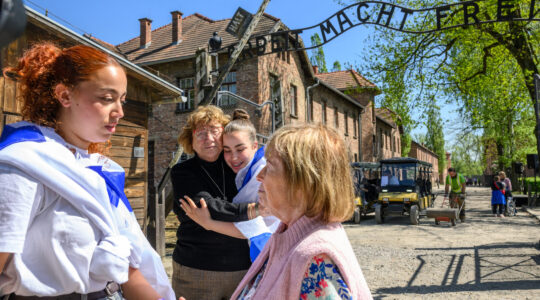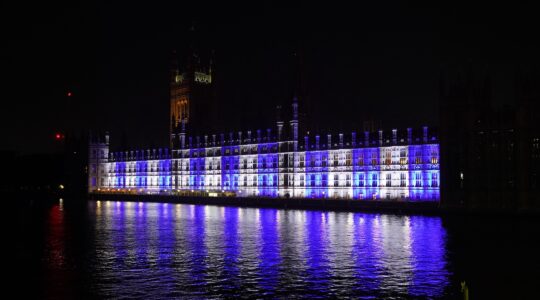KINGSTON, Jamaica (JTA) — Where can you prance with the dolphins and pray in a sanctuary with a sand-covered floor?
Jamaica, for one.
The Caribbean nation is home to one of five synagogues worldwide with sand-covered sanctuary floors — a reminder of the sand that conversos were said to put on their floors to muffle the prayers they recited in secret. It’s also home to one of the oldest Jewish communities in the Western Hemisphere, with the earliest Jews believed to have arrived in the early 1600s, perhaps even the late 1500s.
The tiny, racially mixed community – “200 souls,” according to Ainsley Henriques, the Jewish community’s leader and historian — is proud of its heritage, as both Jews and Jamaicans who helped build the nation.
Jewish travelers seeking something beyond Jamaica’s beaches, mountains, rainforests, dolphin coves, water sports and reggae music can find places that speak to that heritage.
Primary is Congregation Kahal Kadosh Shaare Shalom, the nation’s only synagogue still in existence. The original building, which was dedicated in 1888 for merged Sephardic and Ashkenazi congregations, was destroyed along with much of downtown Kingston in a 1907 earthquake. The rebuilt synagogue, with its Sephardic-style sanctuary, rich mahogany interior, pipe organ and white exterior surrounded by palm trees was dedicated in 1913 and continues to be an active synagogue.
But tourists are often needed to help make a minyan. Congregants are grateful for their guests, warmly greeting them, ensuring they have prayer books, and calling male and female visitors to the Torah.
The congregation uses its own siddur, which draws greatly from the early Reform prayer books, although modified to suit its needs, and includes numerous English translations and Hebrew transliterations.
And you’ll find the challah (made by a local bakery), honey cake and sweet kosher wine that you’d find at a typical kiddush back home.
The grounds include tombstones rescued from an old cemetery, some dating to the 1700s, and a Jewish Heritage Center that serves as a multipurpose room and museum about Jewish life in general and Jewish Jamaica in particular. Tucked in the center’s corner is the Jamaica Jewish Genealogical Institute, where you can trace names such as Henriques, Levy and Matalon back to their Sephardic origins.
While the synagogue itself is beautiful and well maintained, the neighborhood is seedy and it’s not advisable to walk alone. On a recent visit, a security car accompanied journalists on the approximately two-mile walk back to our hotel following Friday night services.
If the synagogue is the main Jewish attraction, reminders of Jewish life can be found at tourist sites, too.
At Fort Charles, a Port Royal fort built by the British to guard against a reinvasion by the Spanish, a maritime museum display includes a Sabbath lamp rescued from the rubble of a 1692 earthquake. The quake leveled much of the area, including Jamaica’s first synagogue, built in the mid-1600s.
The fort itself suffered earthquake damage in 1907, leading a formerly artillery store to tilt and be dubbed the Giddy House. Beware if you have vertigo.
Back in Kingston is Devon House, a colonial mansion built in 1881 for George Stiebel, Jamaica’s first black millionaire and the son of a German Jew. The two-story mansion, later owned by other Jewish families, is now a historic site open to the public. The servant quarters, kitchen and other buildings adjacent to the house have been transformed into shops and eateries, including an ice cream shop that National Geographic last year ranked the world’s fourth-best place to eat ice cream.
The National Gallery of Art of Jamaica houses works by the Jewish artist Isaac Mendes Belasario, a landscape, portrait and folk artist born to a Sephardic family in 1795.
Now about those prancing dolphins. Among the places you can find them is Dolphin Cove Treasure Reef in Ochos Rios, about a 2 1/2-hour drive from Kingston to Jamaica’s north coast. (If you’re like I am and prone to motion sickness, you might want to skip the winding mountain drive and fly directly to Montego Bay for its many resorts and recreational activities.)
Dolphin Cove isn’t solely for encounters with dolphins – you can spend time with colorful birds, touch a stingray, snorkel or paddle a glass-bottom kayak.
But those mammals with the perpetual smiles are hard to resist, and there are several options for dolphin encounters. They range from the tame — standing on a platform in knee-high water while a bottle-nosed dolphin does her tricks, and touching her as she swims by — to the more adventurous dorsal pull, where visitors grab the dolphin’s dorsal fin and let her pull them through the water.
For those interested in climbing a waterfall, try Dunn’s River Falls, where you can put on water shoes and make your way through pools of water and up the rocks and boulders as the crisp, clear waters tumble and rush beneath your feet. I found it terrifying and bailed at the first exit, but the sure-footed might enjoy it.
Another Ochos Rios attraction is Mystic Mountain, which includes zip lines and a bobsled track through the rainforest, a pool with a twisting slide and a hummingbird garden.
Best of all, you’ll get a spectacular view of the Caribbean from the chairlift to and from the mountaintop, with your feet sometimes skimming the lush and sweetly fragrant forest below with its banana, passion, ackee and other trees.
(Debra Rubin visited Jamaica on a Jewish heritage media trip as a guest of the Jamaica Tourist Board.)
JTA has documented Jewish history in real-time for over a century. Keep our journalism strong by joining us in supporting independent, award-winning reporting.





